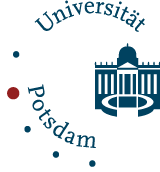Working papers (2017-2018)
N° 6 Sören Schalowski (2017): From Adverbial to Discourse Connective. Multiple prefields in spoken German and the use of dann ‘then’ and danach ‘afterwards’. (EN)
Abstract
"This paper is concerned with a corpus-based investigation of non-canonical, multiple prefields in spoken German where an adverbial constituent linearly precedes another preverbal constituent in a declarative main clause, in short AdvXV. This construction violates the verb second constraint of German. After showing that this serialization is not an instance of random variationand that it has distinctive grammatical properties, the overall question will be: What are the licensing conditions of this construction? It will be shown that one has to distinguish between two triggers of the AdvXV construction: (i) the simultaneous syntactic marking of a frame setter and a topic, (ii) the syntactic marking of temporal discourse connectives. In the latter case the connective adverbs dann ‘then’ and danach ‘afterwards’ are used in the Adv-slot of AdvXV. Their use in this non-canonical syntactic position indicates the development of dann and danach from a lexical category to a discourse-functional category, namely to a connective at discourse level. Placement at the left edge in AdvXV, and therefore at the connecting point of two discourse units, marks this function explicitly."
► PDF (download) (801KB)
N° 7 Darian Gerstenberger (2017): Die Linguistic Landscape von Berlin. Eine Studie zur Repräsentation von Sprachen in ausgewählten urbanen Räumen mit besonderer Beobachtung des Türkischen. (GER)
Abstract
"The paper deals with the sociolinguistic phenomenon of the Linguistic Landscape in two separate districts of Berlin. It investigates the degree to which ethnic diversity influences the visibility of languages within a given territory. This study on linguistic diversity, within the multi-ethnic community of Neukölln, is mainly concerned with two major assumptions. Firstly, that the Linguistic Landscape is the most visible marker, for ethnolinguistic vitality, of various groups living within a particular territorial enclave. Secondly, that the Linguistic Landscape is a marker of the relative dominance of particular ethnolinguistic communities inhabiting the enclave. The study focuses on two separate districts of Berlin, being Neukölln and Kaulsdorf-Mahlsdorf. Moreover, the main focus is on linguistic signs and their agents (initiators). Signs, a key term in Linguistic Landscapes, give information about the agencies and whether they act under control of central policies, or of individual interests. Consequently, the paper investigates the specific status of the Turkish language in the Berlin district of Neukölln. By analysing Turkish bilingual signs, this paper will attempt to demonstrate the usage and distribution of aminority language in the public space."
► PDF (download) (1,12KB)
N° 8 Sarah El Zatoni (2018): Pro-Drop im Kiezdeutschen. (GER)
Abstract
"This paper presents an analysis of pro-drop in Kiezdeutsch, an urban multiethnolect of German primarily spoken by youths. The cases of pro-drop will be investigated by means of linguistic corpus data. The KiezDeutsch-Korpus (2010ff.) consists of a multilingual part (KiDKo/Mu) and a monolingual part (KiDKo/MO). The multilingual part of the corpus contains data recorded by multilingual speakers of Kiezdeutsch from Berlin-Kreuzberg whereas the monolingual part of the corpus contains data recorded by monolingual speakers of German. There is a higher frequency of pro-drop utterances in KiDKo/Mu than in KiDKo/Mo (Wiese & Rehbein 2016). Turkish is one of multilingual speaker’s heritage languages. As Turkish is a pro-drop language, there is a possible influence on Kiezdeutsch. However, so-called topic drop occurs in German as described by Trutkowski (2016). This paper’s analysis is based on Trutkowski’s (2016) results as well as Öztürks (2006) description of pro-drop in Turkish. A theoretical introduction to all relevant concepts is followed by an analysis of the null subjects and null objects in both parts of the corpus to verify the hypothesis of relevant language contact. Grammatical functions, the topological fields of the sentence and linguistic as well as non-linguistic factors which may influence pro-drop will be considered. The conclusion of this paper is that pro-drop in Kiezdeutsch is more similar to grammatical structures of (informal) Standard German and less similar to structures of Turkish."
► PDF (download) (944KB)
N° 9 Malike Clara Altuntaş (2018): Und mit wem switchst du so? Deutsch-türkisches Code-Switching als bilingualer Code: Die Rolle der/des Adressaten*in in der mündlichen Kommunikation bilingualer Erwachsener (GER)
Abstract
"The thesis at hand investigates German-Turkish code-switching as a bilingual mannerof speaking especially of young adults. Based on two sets of data, the current code switching of this speaker group is demonstrated. A slightly modification of anapproach by Heike Wiese enables the acquisition of natural language data. The data consists of brief authentic conversations about a given event. By looking at different research instances, the spokesperson group will be defined more precisely. It is assumed that the factor bilingualism does not necessarily make code-switching predictable, but that the addressee must fulfill further criteria that favor this way of speaking. The cross-sectional study therefore also contains natural langugage data to discuss the extent that this language usage can be described as one bilingual code, contrary to a monolingual view on the language-contact phenomenon. According to this linguistic behavior, it is important to consider the relation between of language-systematics, psycholinguistic explanatory patterns and sociopragmatic aspects. The purely linguistic data are also based on a survey among test subjects in order to better describe the code switching and its speaker group with the help of information about language behavior, perception of language and language environment."
► PDF (download) (2,85MB)
